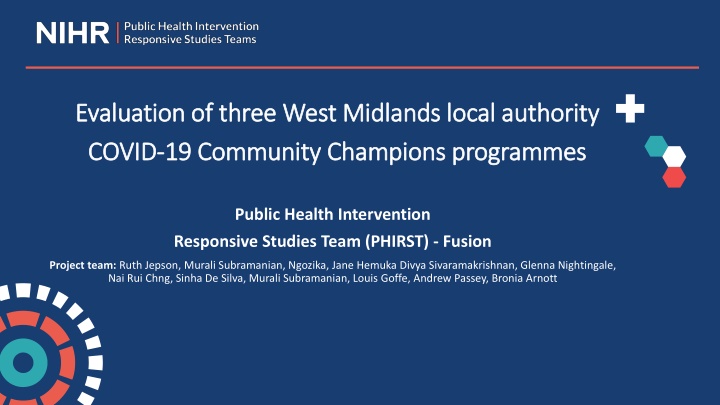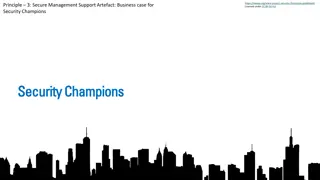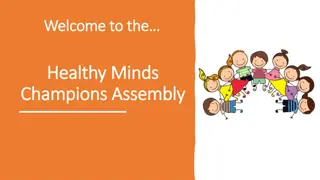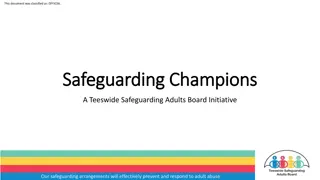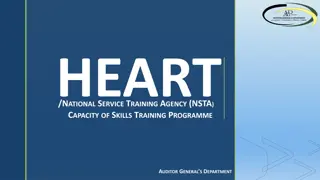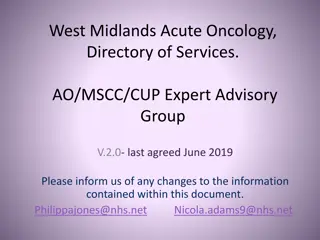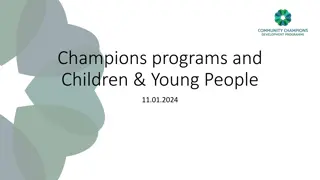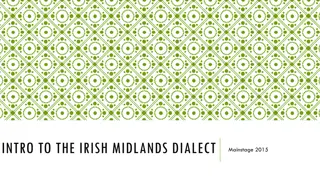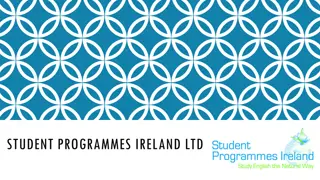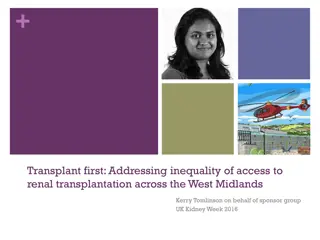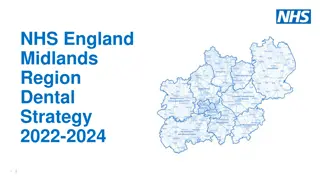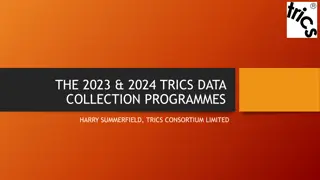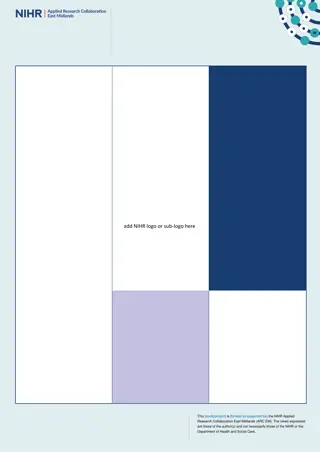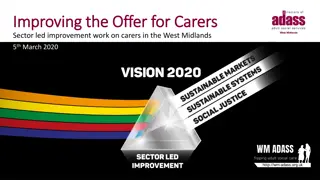Evaluation of West Midlands COVID Community Champions Programmes
Evaluation of three West Midlands local authority COVID-19 Community Champions programmes by the PHIRST Fusion Project team focused on the role of volunteers in addressing vaccine hesitancy. The programmes aimed to strengthen social connections, increase access to services, address concerns among ethnic minorities, build trust, and combat disinformation. Recommendations included improving inclusivity, providing clear guidelines, and sustaining resources for success.
Download Presentation

Please find below an Image/Link to download the presentation.
The content on the website is provided AS IS for your information and personal use only. It may not be sold, licensed, or shared on other websites without obtaining consent from the author.If you encounter any issues during the download, it is possible that the publisher has removed the file from their server.
You are allowed to download the files provided on this website for personal or commercial use, subject to the condition that they are used lawfully. All files are the property of their respective owners.
The content on the website is provided AS IS for your information and personal use only. It may not be sold, licensed, or shared on other websites without obtaining consent from the author.
E N D
Presentation Transcript
Evaluation of three West Midlands local authority Evaluation of three West Midlands local authority COVID COVID- -19 Community Champions programmes 19 Community Champions programmes Public Health Intervention Responsive Studies Team (PHIRST) - Fusion Project team: Ruth Jepson, Murali Subramanian, Ngozika, Jane Hemuka Divya Sivaramakrishnan, Glenna Nightingale, Nai Rui Chng, Sinha De Silva, Murali Subramanian, Louis Goffe, Andrew Passey, Bronia Arnott
Background Vaccines were an important part of the government strategy to tackle the Covid-19 pandemic- Vaccine hesitancy a challenge Significant disparities in vaccine uptake: ethnic minority communities, deprived areas and lower socio-economic groups (Dolby et al, 2022; Gaughan et al, 2022) Government made substantial investment to support the Covid Community Champions programme
CCC programme Community champions are typically volunteers from a local area who act as a bridge between people and health and care services, signposting community members to services, communicating health messages or running outreach sessions Tailored, community-based approach Programme was reoriented toward addressing vaccine hesitancy during Covid-19 https://www.kingsfund.org.uk/blog/2023/07/community- champions-thriving-beyond-covid
PHIRST CCC evaluation Our team: PHIRST Fusion team consisting of members from the University of Edinburgh, Glasgow and Newcastle Evaluate the Covid Community Champions programme in three West Midlands Local Authority: - Sandwell Metropolitan Borough Council - Birmingham City Council - Walsall Council
Review Benefits of Community Champions programmes: Strengthen social connections Increase access to services Address vaccine concerns among ethnic minorities Build trust Address disinformation Essential components for success: Areas for improvement: Inclusivity Acknowledgement of champions Clear guidelines Information verification Balancing demands Autonomy Sustained resources Practical support Sources South et al. (2021) Hussain, Latif, Timmons, Nkhoma, & Nellums (2022) Kamal, Hodson, & Pearce (2021) Evaluation of Newham s COVID-19 Health Champions programme Evaluation of the Lewisham COVID-19 Community Champions programme
Evaluability assessment An evaluability assessment was conducted with the three local authorities to understand the priorities for evaluation and develop the evaluation plan Three online evaluability assessment workshops conducted with stakeholders from Birmingham, Sandwell and Walsall Local Authorities (February and May 2022)
Aim and objectives Aim: To evaluate, through assessing community trust and communication, whether the COVID-19 Community Champion scheme activities in the three local authority areas are transferable to other topics or communities. Objectives 1. To describe the activities delivered in three local authority area sites in terms of: what, when, where, duration, reach. 2. To evaluate whether there is: increased trust across communities increased community trust in local government sustained work & engagement with communities better communication between communities & LA/Public Health 3. To ascertain whether the activities can be linked to a change in vaccine status
Project plan Phase 1: Quantitative analysis to understand the relationship between CCC activities and vaccine uptake across the 3 LAs Phase 2: Qualitative interviews with programme coordinators and community champions. Phase 3: Detailed community surveys with selected communities conducted within two of the three LAs, adding a quantitative depth to our evaluation.
Quantitative exploratory analyses Quantitative exploratory analyses Aims 1. To determine whether vaccine uptake rates can be estimated using administrative data during and prior to the CCC activity 2. To determine whether GP registration rates can be estimated using administrative data during and prior to the CCC activity 3. To create basic visualizations of the CCC activity per Local Authority and of vaccine uptake and GP registrations.
Key data sources 1. UKHSA (UK Health Security Agency): Vaccine uptake data: This data is provided by MSOA by day per LA. The target population for the before CCC period for each MSOA is taken as the total population aged 12+ for a given MSOA on 29 May 2022. England residents only, unique individuals. Of these, the numerators are the number of unique individuals that have received 1,2,3 doses by the date of extraction. The target population is adjusted for the period during the CCC. 2. Public Health England (?): GP registration data: data was provided as the number of GP registrations up to the extraction date per MSOA. GP surgeries of interest, i.e. those located within the boundaries of the three local authorities of interest, with registration data reported monthly for the study period December 2020 to April 2022 3. Councils (Birmingham, Sandwell, Walsall) - Covid Champion Activities
Methods 1. Visualization (maps, graphs) 2. Vaccine uptake rates: 3. For the Vaccine uptake rates, the formulae employed as described below: Vaccine uptake rate = a/b 10000 where a denotes the number of events, and b the population-time at risk. We have used the multiplier 10000. For the population-time at risk we used the target population multiplied by the length (in days) for the period under investigation. 4. GP registration rates
Methods 1. Visualization (maps, graphs) 2. Vaccine uptake rates: 3. GP registration rates: we have used the following approach to obtain a daily percentage rate. GP daily registration rate = 100 * ((d-c))/((c e) )where d denotes the total number of GP registrations at the end of a given timeframe, c, the total number of GP registrations at the beginning of a given timeframe, and e, the length of the given timeframe in days. The population size was not used in this formula due to the fact that we were not able to confirm whether the GP registrations included individuals less than 12 years old.
Results 1. CCC Activity 2. GP registration 3. Vaccine uptake
Results CCC Activity
Results Vaccine uptake Sandwell<- Walsall -> Birmingham l
Results GP registration LA Pre-CCC Peri-CCC Birmingham (n=9) 0.00509 (-0.00101,0.01119) 0.00244 (-0.00476,0.00964) Sandwell (n=15) 0.00654 (-0.00323,0.01631) 0.00197 (-0.00265,0.00658) Walsall (n=21) 0.00310 (0.00100,0.00519) 0.00289 (0.00029,0.00550)
Results Vaccine uptake Table 4: Average rates per Local Authority (Pre- and During- CCC Activity) Local Authority Pre-CCC During-CCC Absolute Diff % Diff Birmingham MSOAs 21.29 (19.36,23.31) 13.99(12.68,15.29) 7.3 (5.08, 9.52) -34.39 with CCC (n=13) Birmingham MSOAs 41.10(38.45, 43.76) 18.36(17.48, 19.24) 22.74 (19.96, 25.54) -55.33 without CCC (n=119) Sandwell MSOAs 39.46(35.33,43.59) 19.59 (18.21,20.98) 19.87(15.57,24.17) -50.35 with CCC (n=19) Sandwell MSOAs 48.89(46.31,51.47) 22.01(20.77,23.26) 26.88(24.08,29.68) -54.98 without CCC (n=19) Walsall MSOAs 46.61(41.79,51.42) 23.16(21.18,25.15) 23.45(18.31,28.58) -50.31 with CCC (n=23) Walsall MSOAs 64.28(60.89,67.66) 30.55(28.59,32.51) 33.73(29.94,37.51) -52.47 without CCC (n=16)
Results Vaccine uptake Table 5: Difference in rates within each Local Authority. The difference in rates across timeframes between MSOAs with and without CCC activity was calculated. Local Authority Difference Lower 95% Confidence Interval Upper 95% Confidence Interval Birmingham -15.44 -18.97110 -11.92407 Sandwell -7.01 10.443621 -3.579537 Walsall -10.28 -13.894917 -6.663017
Qualitative interviews with programme Qualitative interviews with programme coordinators and community champions coordinators and community champions April to June 2023 Three researchers including the embedded researcher from Sandwell council 10 coordinators and 5 COVID-19 community champions across the three LAs were interviewed. A thematic analysis of the interviews was carried out
Themes Barriers and Facilitators to engage with CCC activities Vaccine Toolkit translated into many languages would have been a helpful move .... with lack of trust in the council or in the NHS ..the networks we ve built over all these years finally helped out, and I must say the faith leaders went all out for us Sustainability They are not supported by anybody...if it needs to work, they need better funding, more resources and continued attention
Themes Trust and Distrust Effective communication and open dialogue, built trust. Cooperative engagement within the CCC programme fostered trust. Trust also increased due to successful programme delivery and being seen as a resource of high integrity. Leveraging trust within voluntary organisations boosted vaccine trust. Lived experiences of champions relating to vaccine-related side effects contributed to a culture of mistrust. Historical research exploitation deepened medical mistrust. Lack of responsiveness from local government and local MPs contributed to distrust.
I think the messaging that we were getting from the public health and how we relayed it to people built the trust. The people had more trust with us face to face because it s almost like if you want to trust somebody, you ve got to look them in the eye The trust was gone once, after the first scandal, that was it, because it was almost like no. It couldn t be done. It does because it s coming from a trusted voice isn t it? It s coming from a trusted voice so they do trust what we have to say. trust, because I come from a background of where things are done to ethnic minorities where it wasn't justified...
Themes Transferability COVID-19 Community champions find value in collaborative communication with various sectors. Comprehensive training is essential, and meetings need improvement. Feedback about the meetings...felt they could be much shorter CCC's collaborative model can be transferred to other public health projects. Consider expanding its project portfolio...we could take this learning into everything, from cancer to smoking. I say why not. Addressing rumours/misbeliefs among ethnic communities is crucial It should be the priority to include ethnic minority populations...try resolve their doubts and help remove rumours
Community Surveys Community Surveys Onsite community surveys were conducted in Sandwell (ASDA superstore) and Smethwick (Guru Nanak Gurudwara) - July 2023. A total of 221 valid responses were gathered. 112 Female, 102 Male, 7 Not Reported 49.3% Asians, 32.2% White, 10% Black, 8.5% Others
Transferability/Public Health priorities Transferability/Public Health Priorities Smoking Sexual Health Alcohol Infectious Diseases Physical activity (exercise) Healthy Eating -50 0 50 100 150 200 250 300 350 400 450 Not at all A little A moderate amount A lot A great deal Total
Preferred Communication Methods Preferred Communication Methods A great deal A lot A moderate amount A little Not at all 20.00% 40.00% 60.00% 80.00% 100.00%120.00%140.00%160.00%180.00% Informal communication 0.00% Social media and online communication Verbal communication Written communication Visual communication
References Dolby T, Finning K, Baker A, Fowler-Dowd L, Khunti K, Razieh C, Yates T, Nafilyan V. Monitoring sociodemographic inequality in COVID-19 vaccination uptake in England: a national linked data study. J Epidemiol Community Health. 2022 Jul;76(7):646-652. doi: 10.1136/jech-2021-218415. Epub 2022 Apr 25. PMID: 35470259. Gaughan CH, Razieh C, Khunti K, Banerjee A, Chudasama YV, Davies MJ, Dolby T, Gillies CL, Lawson C, Mirkes EM, Morgan J, Tingay K, Zaccardi F, Yates T, Nafilyan V. COVID-19 vaccination uptake amongst ethnic minority communities in England: a linked study exploring the drivers of differential vaccination rates. J Public Health (Oxf). 2023 Mar 14;45(1):e65-e74. doi: 10.1093/pubmed/fdab400. Erratum in: J Public Health (Oxf). 2022 Dec 1;44(4):936. PMID: 34994801; PMCID: PMC8755382. South, J., Bagnall, A.-M., Jones, R., Passey, A., Woodall, J., Gledhill, R., . . . Stansfield, J. (2021). Community champions: a rapid scoping review of community champion approaches for the pandemic response and recovery. Retrieved from https://www.gov.uk/government/publications/community-champion-approaches-rapid-scoping-review-of-evidence Hussain, B., Latif, A., Timmons, S., Nkhoma, K., & Nellums, L. B. (2022). Overcoming COVID-19 vaccine hesitancy among ethnic minorities: A systematic review of UK studies. Vaccine, 40(25), 3413-3432. doi:10.1016/j.vaccine.2022.04.030 Kamal, A., Hodson, A., & Pearce, J. M. (2021). A Rapid Systematic Review of Factors Influencing COVID-19 Vaccination Uptake in Minority Ethnic Groups in the UK. Vaccines (Basel), 9(10). doi:10.3390/vaccines9101121
